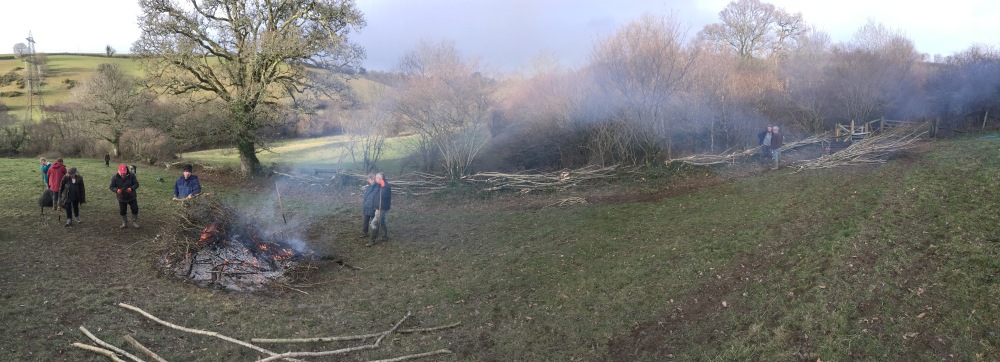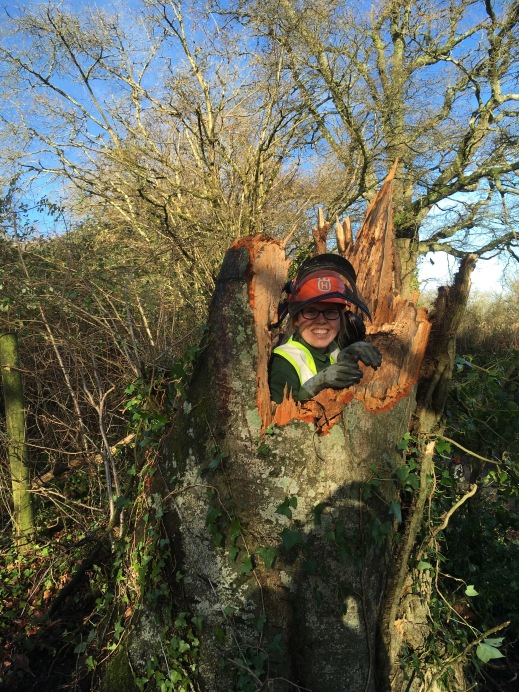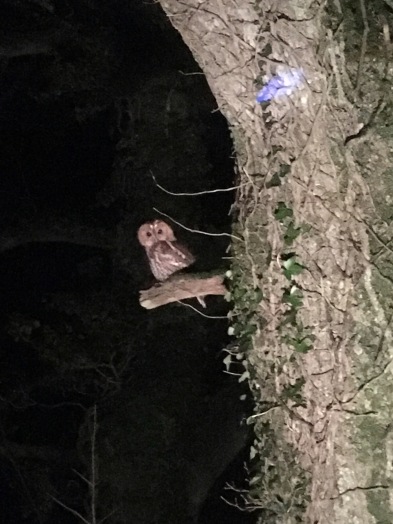The first snowdrops pushing their way up through the warming earth, the days lengthening as the light begins to wrap its arms around a new year and the song birds tentatively testing their voices, starting to build the dawn chorus symphony. Two wonderful super moons later, and its time for a belated January update…
2018 got off to a very wet and muddy start down here in Devon, I can’t think of one January day that didn’t involve rain! Nonetheless, we ventured out to various reserves and continued winter works – a lot of scrub bashing, tree felling and clearing up after the Christmas storms! Luckily a lot of winter tasks involve a bonfire, and if you stand close enough to the heat you can almost imagine it isn’t raining…..
Devon Wildlife Trust has a small but thriving education team, based at the head office in Exeter. They mainly visit children at their schools, but occasionally they organise trips out to nature reserves. Mid January saw a group from an exeter school hop on a coach and travel up north to Meeth Quarry. I was asked to come along to help out, and what a treat it was! A group of year 5/6s, full of excitement at being out of the classroom for the day, were shown how to safely use bow saws and loppers, and set to work cutting down scrub. The enthusiasm they threw at the task and the smiles on their faces were testament to the value of getting children outside, teaching them the importance of nature and fostering their connection with it. After a morning of chopping and feeding a bonfire, the kids settled round a camp fire to whittle sticks for marshmallow toasting and went on a short walk to see the lake. The squeals of awe at the size of the lake, and the intrigue at the handfuls of clay we dug from a mound by the track were catching, and as is always the way when I help out the education team, I finished the day with a smile on my face. It is always humbling to be a part of days like this, and it never ceases to feed the flames of hope in my mind that not all is lost in our fight to protect the natural world. The next generation of conservationists, activists and naturalists in the making……
As you may remember from a previous post, before Christmas I went along to a hedge-laying day with the Greater Horseshoe Bat project and Devon Rural Skills. A few weeks ago I had a chance to put my newly gained skills to the test with our regular volunteer group! It was another day linked to the bat project, as the site is one that is linked with the Chudleigh Greater Horseshoe Bat roost, and therefore one where the bat team advisors are working with the landowners to try and improve habitat for these fascinating creatures. Bats use hedgerows as corridors to navigate their way around the landscape, so a well managed hedge is an easy route to helping them out. With lots of eager hands we made swift progress along the bank, aided by the fact that most of what we were laying was hazel – a nice easy tree to lay into a hedge! John, the landowner, was on hand to give advice from his many years of experience, and seemed please with the end result! As always, a big shout out to our wonderful volunteers who come along and get stuck in to whatever task is thrown their way. I hope the bats appreciate our work!

From our only true flying mammal to our only mammal with a prehensile tail…. The UK’s smallest rodent, the Harvest Mouse, is drastically under recorded in Devon, so the Devon Mammal Group launched a project to try and combat this lack of records. A few of us from the reserves team went along to one of their survey training days to learn a bit more about this tiny but charismatic creature, and what to look for when hunting for harvest mouse nests. It was fascinating to learn a bit about the history of harvest mice, and their presumed decline in recent years, possibly due to changes in cropping density, increased size of machinery and altered harvesting practices. However, it is impossible to determine the extent of their decline without accurate records of where harvest mice are present/absent. So out we went into the field to hunt for nests! Harvest mice build their nests out of living grass, in the middle of tussocks. Their breeding nests are intricately woven, three layered spheres. They look much like a dormouse nest, except they are attached to the surrounding grass, and are generally around 15cm off the ground. They have a second type of nest for single use, much more scraggly loosely woven affair. Granted, we were at a site where we knew we would find nests, but it was still amazing how many we found once we got our eyes in! Anyone keen to head out and search for harvest mouse nests, check out rough grassland, meadows and tall grassy verges. Winter is the only time you should go nest hunting so as not to disturb the mice when they are raising their broods!

January has also seen a new addition to our team at Woodah – Alice has joined myself and Simeon for the last few months of our traineeship! Having already been part of the North Devon reserves team, we had met before and she has quickly become as much a part of the team as the rest of us, and it is lovely to have another person to join the crew. I knew she would fit right in when, in the first week she was with us, we went to clear up a large tree that had fallen across a road and she decided to check out the extent of the rot within the remaining tree trunk.. by climbing in it!

One of the perks of working out in the big wide world of nature, is seeing the seasons turn and how the tasks required change as the months pass. It is easy to forget how one seasons work feeds into the next when in the depths of winter chainsawing. Last week I had a heartwarming reminder of the interconnectedness of all the work we do, and how it all links together and feeds back into itself in one way or another. Back in the summer, I spent few days with the Avon Valley project team helping to harvest seed from wild flower meadows in the South Hams. We brought the seed back to Woodah and dried it out, then bagged it up for the project to use on other farms. I thought no more of it, until last week when I was tasked with sowing wild flower seed around the fields at Woodah. Scuffing up the ground to expose the bare ground, scattering handfuls of seeds and treading them into the earth with the sun shining down – a simple process, but a very fulfilling job, knowing that in the coming summer the ground could see Yellow Rattle pushing up to begin increasing the diversity of the sward. It was lovely to have seen the seed all the way from harvest to sowing, a reminder of the importance of building communities to share resources (eg seeds), knowledge and nurture connections to allow for better and more joined up conservation action.
I will leave you with this beautiful little Tawny Owl that I had the privilege of encountering on a late night drive home down the lanes on evening, perks of living outside of town!
